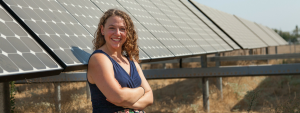 By Ellen Shenette, Manager, EDF Climate Corps
By Ellen Shenette, Manager, EDF Climate Corps
I remember some of the first interactions I had with companies working in the clean energy industry. I was an analyst at the time, which meant the conversations were more often than not, very technical, wonky, and with men. At first, this was overwhelming. But my all-women MBA program prepared me for the male-dominated business world. I turned these initial concerns into motivation, and I built my technical expertise so that I could hold my own in conversations. If my knowledge was questioned, I was ready with an answer.
I’m not alone in this experience. Like many other STEM industries, women are underrepresented in the energy workforce, counting for only roughly 20-35 percent. The good news is that this trend is changing, and clean energy is leading the way. The clean energy sector is the farthest along in closing this gender gap compared to other energy sectors, opening up numerous opportunities for women looking to start their careers in this field, and I’m proud to be helping to make this possible.
EDF Climate Corps is working to build the next generation of sustainability leaders, and we’re making sure that includes women. Why? Research has found that more gender equity leads to higher performing companies, and female leaders rank the highest in their ability to take initiative and drive results.
Since EDF Climate Corps started in 2008, women have represented 41 percent of our fellows. I decided to reach out to these women from our alumni network, a group of nearly 850 sustainability experts, and learn more about their jobs and gather any advice they have for women looking to join the industry.
[Tweet “Meet the women of the clean energy and sustainability workforce”]
All of the women I spoke to noted they are outnumbered by men in their work. Alumnae from the EDF Climate Corps class of 2016 – Beatrice Troiano, a specialist in distributed generation at Con Edison and Grace McGinnis, a field solar specialist at Sunrun – said “they are used to being one of few women.” And Donna Sanders, CEO and co-founder of Social Solar, also a 2016 fellow, added that she’s seen very few women in leadership roles.
This gender imbalance might also vary depending on a specific job function. Leanna McKeon, a senior energy analyst at the Chicago Housing Authority and a 2014 fellow, says while working on engineering and construction projects she’s often the “only woman in the boiler room,” but during policy meetings the room is generally split evenly by gender.
How do we get more women into these job opportunities that are out there?
Why does this gender imbalance exist? Well, there are a few reasons. A lot of it comes from the fact that the clean energy and sustainability field is closely connected with other industries – like construction, engineering, sales, etc. – which have been traditionally male-dominated.
Elizabeth Halford, a 2015 fellow, said that her job as a project manager with Elevation Greenroofs LLC, was a cross between construction, landscaping and roofing, which are jobs usually held by men. Grace found this to be true for her sales role: “Most of the people I work with come from a sales background, and in my experience sales is usually also male-dominated. It’s a very competitive culture, one of ‘crushing the competition, almost like a sports competition.”
But the important question, is how do we get more women into these job opportunities that are out there? Here’s what I suggest:
- Be an expert! Build your technical expertise and let your experience show. Even on-the-job learning is extremely helpful. “Because of the highly technical nature of the clean energy industry, knowledge and expertise can help overcome any potential disadvantage of working in a male-dominated environment,” explains Beatrice. There’s been a recent push for more women to be trained in STEM subjects, which she says “will attract more women and move towards a balanced distribution between genders.”
- Highlight what you can bring to the table. Let others know how your skills, including any schooling or qualifications, can set you apart from others and be a useful addition to a project. Voicing your skills and interest areas can also show that you are eager to contribute to the team. Elizabeth spoke of an intern who said that she had helpful skills – like writing and research – that could help with a specific task. Shortly after, she was hired into a full-time position. Many of the women added that they are leveraging, and being recognized for, the special skillsets that they possess. And, they’ve been welcomed as “a breath of fresh air” for being a woman, both from clients and colleagues.
- Build your network and advocate for other woman. I believe this to be the most important step we can take to get more women in this field. We need to establish mentoring groups, networks and forums to facilitate the sharing of best practices and strategies for overcoming challenges. “I am extremely fortunate to have made important connections with other women early in my career who have encouraged and mentored me,” said Leanna. “And we need more women represented on panels at conferences to serve as role models for others.” As part of her startup, Donna works with young kids in Harlem, exposing them to the types of jobs they could have in the clean energy space. “When I speak to them,” says Donna, “I notice young girls welcome me, and I think it’s very useful for some of the girls, especially the minority girls, to see me.”
The clean energy and sustainability industry is considered a new, “disruptive industry,” which means we’re seeing more job opportunities being filled by a younger and more gender-balanced workforce. And this trend is only going to continue.
So, women, our time is now.
P.S. Happy Women’s History Month!
This post originally appeared on our EDF+Business blog.









